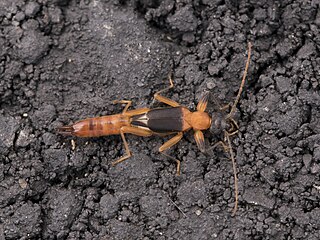
Giant cockroaches, or blaberids, are the second-largest cockroach family by number of species. Mostly distributed in warmer climates worldwide, this family is based on the American genus Blaberus, but much of the diversity is also found in Africa and Asia.

Blattidae is a cockroach family in the order Blattodea containing several of the most common household cockroaches. Notable species include:

Ectobiidae is a family of the order Blattodea (cockroaches). This family contains many of the smaller common household pest cockroaches, among others. They are sometimes called wood cockroaches. A few notable species include:

Periplaneta is a genus of cockroaches containing some of the well-known pest species with cosmopolitan distributions, such as:

Anisolabis is a genus of mostly Asian earwigs in the subfamily Anisolabidinae. It was cited by Srivastava in Part 2 of Fauna of India. The name Anisolabis stems from the asymmetry of the male cerci; the right cercus being more acute than the left.

Ectobius is a genus of non-cosmopolitan cockroaches once thought native to the Old World and described by James Francis Stephens in 1835, belonging to the family Ectobiidae, subfamily Ectobiinae. The discovery of 4 ectobius cockroaches in Colorado dating to 49 million years ago suggests the genus actually originated in North America. This genus has been subject to a number of revisions.

Pseudophoraspis is a genus of South-East Asian cockroaches, erected by William Forsell Kirby 1903.

Neostylopyga is a genus of cockroaches described by Robert Walter Campbell Shelford in 1911.

Rhabdoblatta is a genus of cockroaches in the subfamily Epilamprinae. Species have been recorded from Africa, East, Southeast and South Asia.

Balta is a genus of cockroaches in the sub family Pseudophyllodromiinae. Found in Asia, Africa, Australia and Oceania. The genus was created in 1893 by Johann Tepper.

Anaplecta is a genus in the family Anaplectidae. There are at least 20 described species in Anaplecta.

Diplatys is a genus of Asian earwigs, in the family Diplatyidae, erected by Jean Guillaume Audinet-Serville in 1831. The recorded distribution of species is from Indochina, although this may be incomplete; it is also worth noting that other genera in subfamily Diplatyinae and the genus Haplodiplatys historically have been placed here.

Panesthia is a large genus of burrowing giant cockroach in the subfamily Panesthiinae. It is subsocial and its species are mainly found in Southeast Asia, coastal East Asia, Australasia, and Indo-Malaysia.

Allacta is a genus of SE Asian and Australian cockroaches in the subfamily Pseudophyllodromiinae.

Corydidarum is a genus of Asian cockroaches in the subfamily Perisphaerinae, erected by Carl Brunner von Wattenwyl in 1865. The recorded distribution is central Africa, India, China, SE Asia through to New Guinea.

Paranauphoeta is a genus of South East Asian cockroaches in the family Blaberidae and the monotypic subfamily ParanauphoetinaeRehn, 1951, erected by Carl Brunner von Wattenwyl in 1865. Species records are from India, China, Indochina, Malesia and New Guinea.

Calolamprodes is a genus of Asian cockroaches in the family Blaberidae and the monotypic subfamily CalolamprodinaeWang & Wang, 2023, erected by G.Y. Bey-Bienko in 1969. Species have been recorded from India, China and Indochina.
Dorylaea is a genus of South-East Asian cockroaches in the subfamily Blattinae erected by Carl Stål in 1877. Species are sometimes called "darkling cockroaches" and their known distribution is almost certainly incomplete: having been recorded from Vietnam then peninsular Malaysia, Sri Lanka and most of Malesia including Taiwan through to Australia and the West Pacific islands.

Ellipsidion is a genus of cockroach in the family Ectobiidae. According to the Cockroach Species File, it contains eighteen species:


















